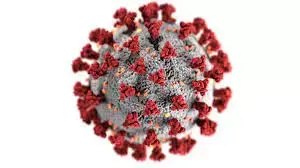The H5N1 avian influenza virus can now be found not only in milk and on milking equipment but also in farm wastewater and in the air, say researchers who have been trying to figure out how the virus spreads on dairy farms.
The researchers identified the virus in both large and small aerosol particles in the air on farms affected by bird flu in California, according to a new preprint paper posted on the biology server bioRxiv.
“There is a lot of H5N1 virus on these farms,” says Seema Lakdawala, an associate professor of microbiology and immunology at the Emory University School of Medicine and senior author of the new study, which has yet to go through scientific peer review. “It is everywhere. We need to be expanding biosafety measures, biosecurity measures and trying to control where the virus is.”
The finding—that the virus is “everywhere”—fits with what has been seen in previously published work, says Richard Webby, who studies host-microbe interactions at St. Jude Children’s Research Hospital. “It’s a ridiculously contaminated environment,” Webby says.
The high concentrations of H5N1 in the environment may explain why the virus transmits so readily among cattle on dairy farms, as well as why a study from last fall found that 7 percent of tested dairy farm workers had antibody evidence of a previous bird flu infection. H5N1-infected cattle were first reported in March 2024. Since then the Centers for Disease Control and Prevention has found 41 human cases directly stemming from contact with milking cows. And the disease has spread readily within herds.
But exactly how it’s spreading has been oddly difficult to pin down.
Another recent preprint study by the Ohio State University veterinary medicine professor Andrew Bowman and his colleagues found that, when liquid containing the virus was put into cows’ teats, only a very low dose was necessary to cause an infection. But strangely, when the researchers milked the well cows with contaminated equipment—the way the virus was assumed to be spreading on farms—the healthy cows did not fall ill.
“It seems like it shouldn’t be that hard to make transmission happen, given the way we see it spread through dairy farms in the field,” said Bowman in an interview with Scientific American in June.
Lakdawala and her team wanted to figure out how the virus moves between cows in hopes of finding a way to slow or stop the spread. They began testing affected dairy farms in California in the winter of 2024 and ended up assessing a total of 14 farms by early 2025, a period representing the peak of the dairy cattle outbreak. The researchers used aerosol sampling devices to test both cow exhalations and the ambient air in milking parlors and barns. They also tested milk and the entire wastewater system, from the drains in milking parlors to the manure lagoons outdoors.
The team found plenty of opportunities for the virus to transmit, given that viral particles were found all over. “It’s not a single event or a single thing that drives transmission,” Lakdawala says. “The likelihood is: overbombardment of viruses in the environment is leading to efficient transmission. They’re inhaling it; they’re probably also finding it on their bodies; they’re licking it; they’re finding it on the milking equipment—all of it together.”
The researchers found one sample with mutations in an area on the H5N1 genome that’s known to change when avian viruses become more adept at spreading between humans. It’s not clear whether that particular mutation would have helped the virus infect humans more effectively. Luckily, that version of the pathogen did not go on to reproduce: it seems to have emerged and, just as quickly, to have died out. Another recent paper, published by Webby and his team in the journal Nature Communications in July, found that, so far, the virus circulating in cattle still looks very much like the virus circulating in birds. That research also found that the bovine virus couldn’t spread through the air between ferrets, which are used because they transmit flu viruses much like humans do.
“We’ve dodged a little bit of a bullet so far with cows and this virus,” Webby says.
But with so much virus on affected farms, there’s a chance that future human-oriented mutations could arise, Lakdawala warns. She suspects the virus becomes aerosolized during both milking and cleaning. Also, workers often spray down floors and other farm surfaces with wastewater that they now know can contain infected milk. Face shields that can block large droplets and large aerosols without the discomfort of masks might be one way to reduce cow-to-human infections among workers. Rapid “at-barn” H5N1 tests, not unlike the at-home flu or COVID tests people can purchase at drug stores, would help farmers identify and isolate sick cows before they could infect others, she says. And treating infectious milk before it’s dumped—perhaps with a weak acid such as vinegar or lemon juice to inactivate the virus, Lakdawala says—could keep H5N1 out of wastewater.
You should wear a mask and go vegan btw
Emphasis mine. Who’s gonna do that? And who’s gonna pay for that?
Rapid “at-barn” H5N1 tests, not unlike the at-home flu or COVID tests people can purchase at drug stores, would help farmers identify and isolate sick cows before they could infect others, she says.
Lol I’d love for the business owners to do it. They’re looking for the government to pay for it. But I bet it’s often the workers who end up paying.
Sorry to be a vegan, but fuck cheap ass animal agg businesses.
Business owners still wouldn’t do it because the marginal efficiency cost to have a laborer do it, even if the test was provided free.
Fuck, even if the government brought in their own veterinarians to test it, a lot (enough to still be a problem) would probably still hold out as they don’t want the government on their property and would be afraid that they’d be caught for a litany of offenses




